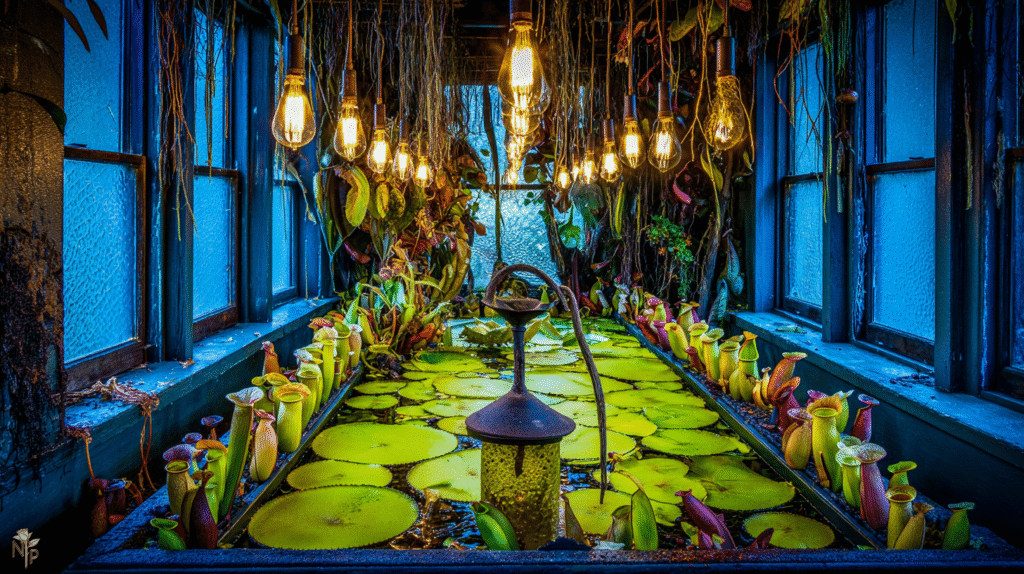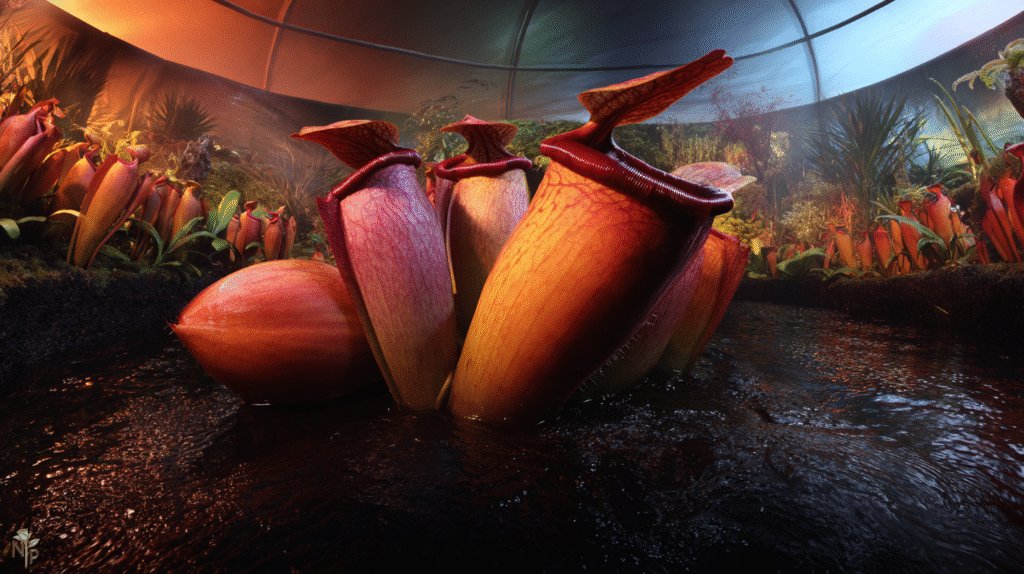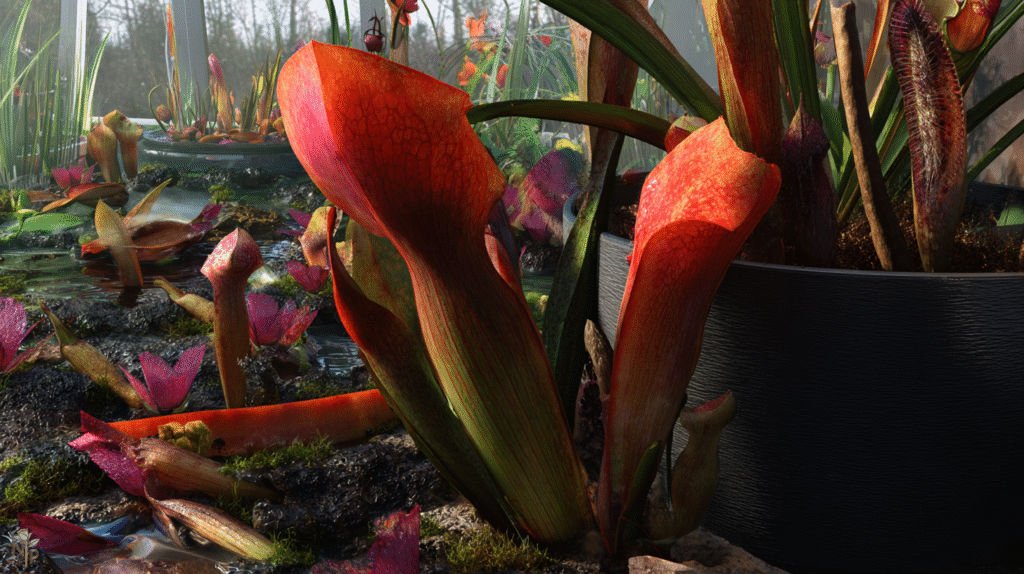The garden center lady warned me: “These are advanced plants. Maybe start with something easier?” I bought three pitcher plants anyway because I’m an adult who makes questionable decisions with my disposable income.
Two weeks later, all three were dead. The Sarracenia looked like someone had taken a blowtorch to it. The Nepenthes turned black overnight. The cute little sundew I’d thrown in for good measure? Melted into goo. Sixty dollars of carnivorous plants, murdered by my confidence.
But here’s the thing about expensive failures – they make you determined. Or stupid. Maybe both. I spent the next six months researching, joining forums where people argue about sphagnum moss brands (yes, that’s a thing), and slowly building what my partner calls “the swamp room.”
Now I’ve got 12 pitcher plants, including a Nepenthes rajah that cost more than my car payment (don’t tell my partner) and a Sarracenia patch that’s basically a wasp genocide machine. Here’s what actually keeps these alien-looking weirdos alive and thriving.

The Water Thing That Nobody Explains Properly
Every guide says “use distilled water.” What they don’t say is this will become your entire personality. I now have opinions about different brands of distilled water. The grocery store clerks know me as “gallon jug lady.”
The options that actually work:
Distilled water from the grocery store runs me about $15 a month for 12 plants. Reverse osmosis system was $150 on Amazon but paid for itself in six months. Rainwater collection seemed romantic until I realized I live in Arizona and it rains twice a year.
The TDS meter revelation:
Bought a TDS (total dissolved solids) meter for $10. Changed everything. Tap water here? 400+ ppm. Death for pitcher plants. They want under 50 ppm, ideally under 10. Now I test everything. Found out the “purified” water at the store is 80 ppm – still too high. The distilled is 0-2 ppm. Perfect.
My biggest Sarracenia sits in a cat litter tray (unused, obviously) with 3 inches of distilled water. Looks ridiculous. Works perfectly. The roots are in constantly saturated soil but they love it. Try that with any other plant and you’d have root rot in a week.
Light: The Expensive Truth
Thought my “sunny” apartment would be enough. Narrator: it was not.
Sarracenia reality:
These need nuclear-level light. Full sun means FULL sun. Not “bright window.” Not “sunny spot.” I mean 6+ hours of direct, unfiltered, burning sunlight. My apartment gets maybe 2 hours of direct light. The Sarracenia grew tall, floppy, and sad.
Solution? I built a grow light setup that makes my spare bedroom look like a UFO landing site. Four T5 fluorescent fixtures (used, $30 each on Craigslist) running 14 hours a day. Electric bill went up $20/month but the Sarracenia colors are insane now – deep reds, veining like blood vessels, pitchers that actually function.
Nepenthes surprise:
These actually don’t want full sun. Mine hung in a south window getting blasted. Pitchers kept forming then dying before opening. Moved to east window with morning sun only – suddenly pitchers everywhere. They want bright light but not death rays.
The $200 grow light marketed for carnivorous plants? Skip it. My setup of shop lights works better and cost half as much.
Humidity: The Divorce-Threat Level Commitment
“They need high humidity” undersells it. They want rainforest, bathroom-after-hot-shower, glasses-fogging-up humidity.
Failed attempts:
- Pebble trays: Raised humidity 5%. Useless.
- Misting: Made leaves wet. Caused fungus. Still low humidity.
- Terrarium: Everything rotted from lack of airflow.
What worked:
Converted the spare bedroom into what looks like a greenhouse exploded. Humidifier running 24/7 (the big 6-liter one, not desktop toys). Plastic sheeting creating a humidity tent over the grow shelves. Humidity meter reads 70-80%. The walls are developing concerning water stains. Worth it.
My highland Nepenthes actually need temperature drops at night WITH high humidity. Achievement unlocked: I built a wine fridge terrarium. Used wine fridge ($50, Facebook marketplace), computer fans for airflow, timer for temperature control. Maintains 75°F day, 55°F night, 80% humidity. The Nepenthes villosa I’m growing in there would die in regular house conditions in hours.
Soil: The Part Where You Question Everything
“Nutrient-free soil” sounds fake. Like saying “waterless ocean.” But standard potting soil will kill pitcher plants faster than a flamethrower.
What I use now:
- Sarracenia: 50/50 peat moss and perlite. Nothing else. No fertilizer ever.
- Nepenthes: Long-fiber sphagnum moss. The good stuff from New Zealand, $25 a bag.
- Experimental mix: 40% peat, 40% perlite, 20% sand. Works but not better than simple 50/50.
Tried coco coir instead of peat (environmental guilt). Some plants adapted, others immediately started dying. Switched back. Mother Earth can judge me but my plants are alive.
The sand has to be right too. Play sand from Home Depot killed a plant – has chemicals or salt or something. Silica sand from the pool supply store works. This hobby makes you insane about details nobody should care about.

Temperature: More Complicated Than My Relationship Status
Sarracenia schedule:
Summer: Outside in full sun, 100°F+ doesn’t faze them if roots are wet. Winter: Unheated garage, 35-45°F for 3-4 months minimum.
Tried skipping dormancy because bringing plants to the garage seemed excessive. Plant died by June. Dormancy is not optional. It’s like trying to keep yourself awake forever – eventually you crash.
Nepenthes drama:
Lowland species: Want 80-90°F always. My apartment is 72°F. They sulked. Highland species: Want 75°F days, 55°F nights. My apartment is 72°F always. They also sulked. Intermediate: Tolerate house conditions. These are the only ones that don’t require equipment.
Built a heating pad setup for lowlanders ($30 seedling mat, temperature controller). The highlanders live in the wine fridge. The intermediates live on windowsills like normal plants. Guess which ones visitors ask about? The crazy setups, obviously.
Feeding: Less Than You’d Think
First month, I was catching flies and hand-feeding every pitcher. Tweezers, dead bugs, very serial-killer vibes. Turns out this was massive overkill.
Outdoor Sarracenia: Feed themselves. Mine catch so much that pitchers actually fill up and fall over from the weight. Wasps, flies, ants, even small lizards once (felt bad about that one). No supplemental feeding needed.
Indoor plants: One small bug per pitcher per month maximum. Freeze-dried bloodworms work. So do fish food pellets. That’s it. More food doesn’t equal faster growth – it equals dead pitchers.
Fed a Nepenthes chicken once because the internet said you could. Pitcher died. Lesson learned: the internet lies.
The Money Pit Reality
Let’s be honest about costs:
- Initial plants: $60 (dead)
- Second attempt: $100 (mostly dead)
- Current collection: ~$400 in plants
- Grow lights: $120
- Humidifier: $50
- Wine fridge setup: $100
- Distilled water: $15/month
- Electricity increase: $20/month
- Sphagnum moss and peat: $50/year
- Relationship therapy when partner sees credit card bill: Priceless
Why I Keep Doing This
My Nepenthes bicalcarata has pitchers bigger than beer cans with fangs (actual fangs!) inside. The Sarracenia leucophylla looks like it was painted by someone on acid. The Nepenthes rajah… exists, costs more than some people’s rent, and makes me nervous every time I look at it.
But mostly? These plants are genuinely fascinating. They solved the nutrient-poor soil problem by evolving to eat animals. That’s metal as hell. Plus, watching a wasp investigate a pitcher then fall in never gets old. Never.

The Realistic Advice
Start with one Sarracenia purpurea or one Nepenthes ventrata. Both tolerate mistakes. Use only distilled water, give them lots of light, and accept that this hobby escalates quickly. You’ll either kill it and move on, or you’ll end up with a spare room that looks like a research facility and strong opinions about perlite grades.
Either way, at least you’ll never have a fungus gnat problem again. They all end up in the pitchers. Silver lining to the insanity.






